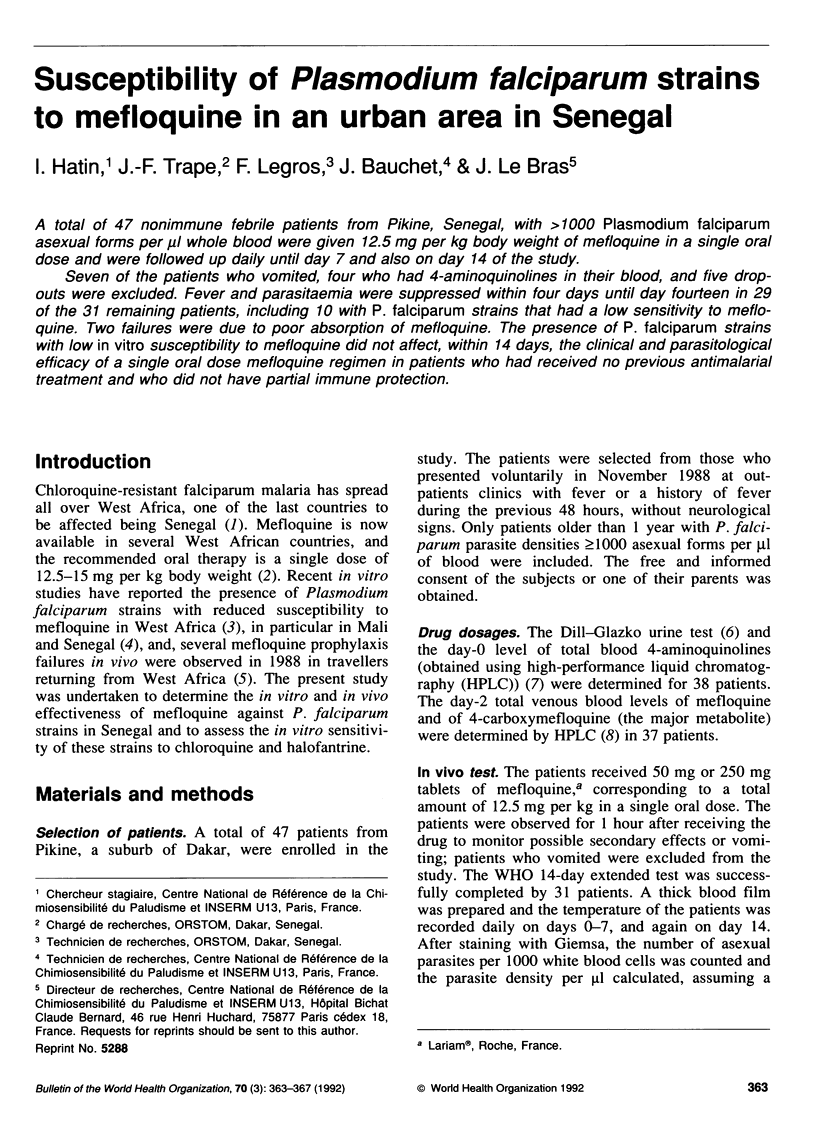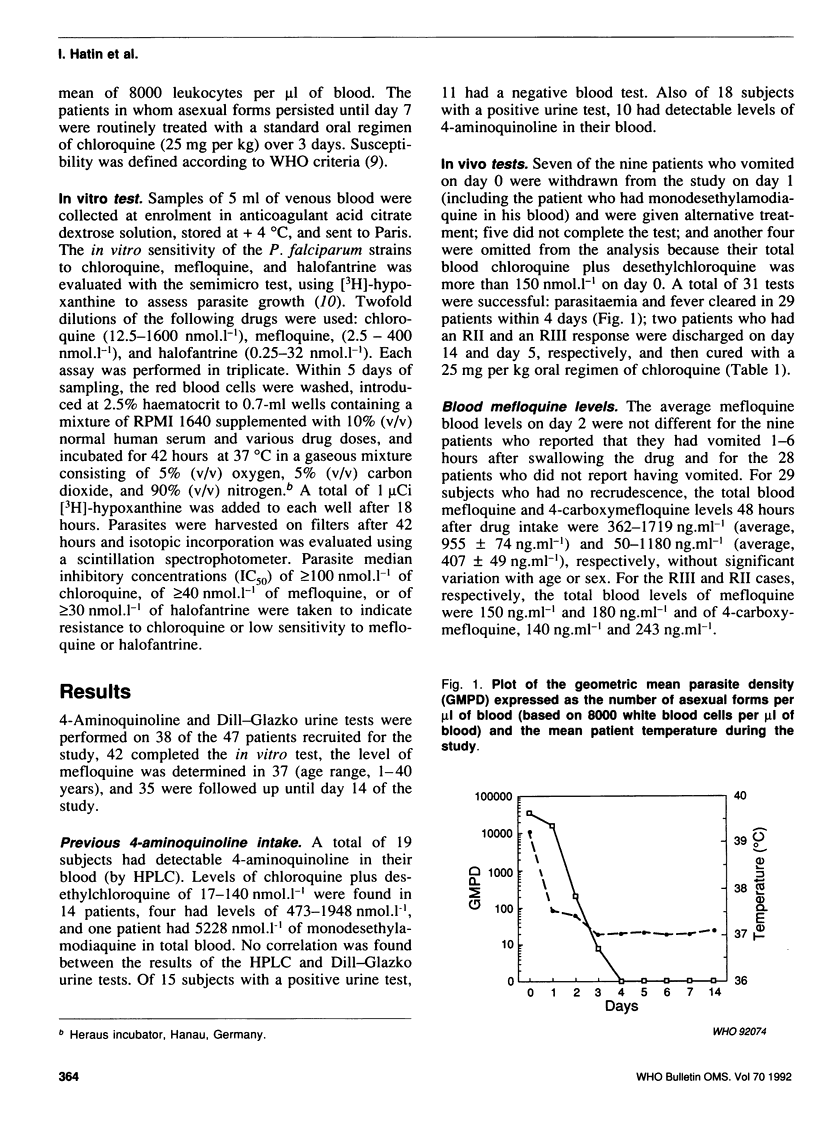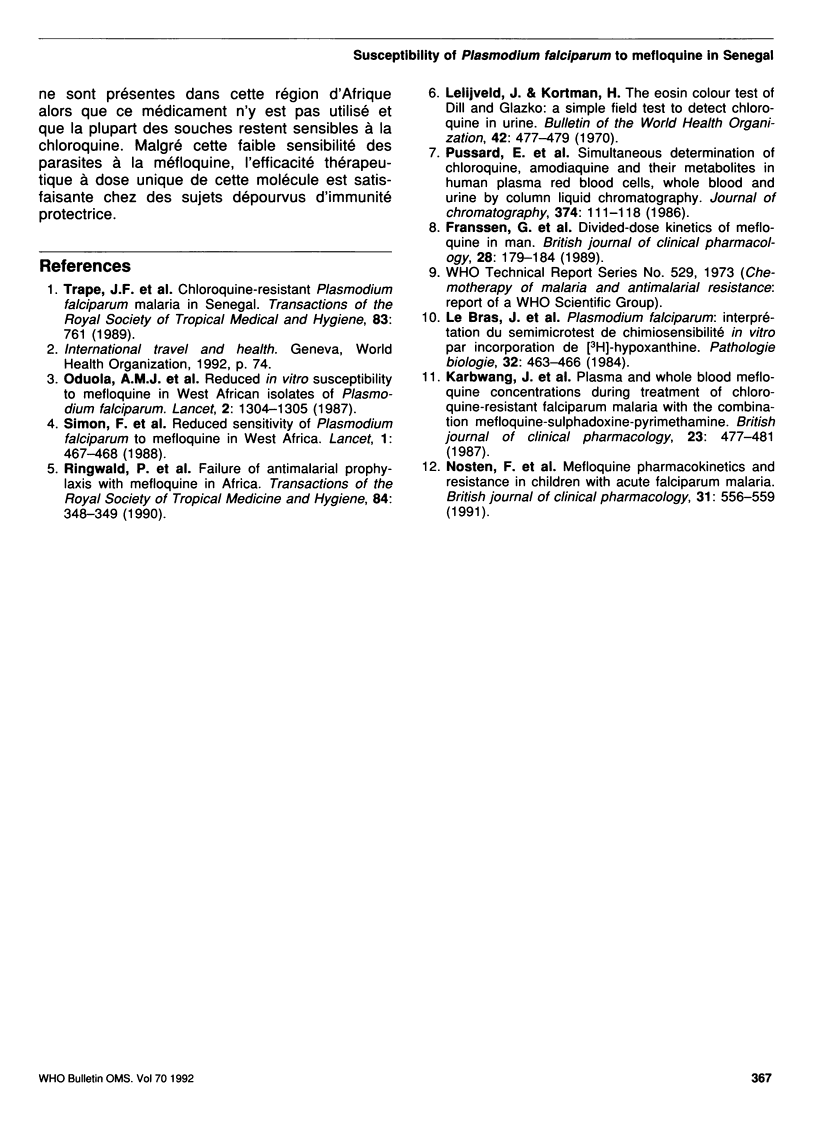Abstract
A total of 47 nonimmune febrile patients from Pikine, Senegal, with greater than 1,000 Plasmodium falciparum asexual forms per microliter whole blood were given 12.5 mg per kg body weight of mefloquine in a single oral dose and were followed up daily until day 7 and also on day 14 of the study. Seven of the patients who vomited, four who had 4-aminoquinolines in their blood, and five dropouts were excluded. Fever and parasitaemia were suppressed within four days until day fourteen in 29 of the 31 remaining patients, including 10 with P. falciparum strains that had a low sensitivity to mefloquine. Two failures were due to poor absorption of mefloquine. The presence of P. falciparum strains with low in vitro susceptibility to mefloquine did not affect, within 14 days, the clinical and parasitological efficacy of a single oral dose mefloquine regimen in patients who had received no previous antimalarial treatment and who did not have partial immune protection.
Full text
PDF




Selected References
These references are in PubMed. This may not be the complete list of references from this article.
- Karbwang J., Looareesuwan S., Phillips R. E., Wattanagoon Y., Molyneux M. E., Nagachinta B., Back D. J., Warrell D. A. Plasma and whole blood mefloquine concentrations during treatment of chloroquine-resistant falciparum malaria with the combination mefloquine-sulphadoxine-pyrimethamine. Br J Clin Pharmacol. 1987 Apr;23(4):477–481. doi: 10.1111/j.1365-2125.1987.tb03079.x. [DOI] [PMC free article] [PubMed] [Google Scholar]
- Le Bras J., Andrieu B., Hatin I., Savel J., Coulaud J. P. Plasmodium falciparum: interprétation du semi-microtest de chimiosensibilité in vitro par incorporation de 3H-hypoxanthine. Pathol Biol (Paris) 1984 May;32(5):463–466. [PubMed] [Google Scholar]
- Lelijveld J., Kortmann H. The eosin colour test of Dill and Glazko: a simple field test to detect chloroquine in urine. Bull World Health Organ. 1970;42(3):477–479. [PMC free article] [PubMed] [Google Scholar]
- Nosten F., ter Kuile F., Chongsuphajaisiddhi T., Na Bangchang K., Karbwang J., White N. J. Mefloquine pharmacokinetics and resistance in children with acute falciparum malaria. Br J Clin Pharmacol. 1991 May;31(5):556–559. doi: 10.1111/j.1365-2125.1991.tb05581.x. [DOI] [PMC free article] [PubMed] [Google Scholar]
- Oduola A. M., Milhous W. K., Salako L. A., Walker O., Desjardins R. E. Reduced in-vitro susceptibility to mefloquine in West African isolates of Plasmodium falciparum. Lancet. 1987 Dec 5;2(8571):1304–1305. doi: 10.1016/s0140-6736(87)91195-0. [DOI] [PubMed] [Google Scholar]
- Pussard E., Verdier F., Blayo M. C. Simultaneous determination of chloroquine, amodiaquine and their metabolites in human plasma, red blood cells, whole blood and urine by column liquid chromatography. J Chromatogr. 1986 Jan 10;374(1):111–118. doi: 10.1016/s0378-4347(00)83258-2. [DOI] [PubMed] [Google Scholar]
- Ringwald P., Bartczak S., Le Bras J., Bricaire F., Matheron S., Bauchet J., Coulaud J. P. Failure of anti-malarial prophylaxis with mefloquine in Africa. Trans R Soc Trop Med Hyg. 1990 May-Jun;84(3):348–349. doi: 10.1016/0035-9203(90)90311-2. [DOI] [PubMed] [Google Scholar]
- Simon F., Le Bras J., Gaudebout C., Girard P. M. Reduced sensitivity of Plasmodium falciparum to mefloquine in West Africa. Lancet. 1988 Feb 27;1(8583):467–468. doi: 10.1016/s0140-6736(88)91253-6. [DOI] [PubMed] [Google Scholar]
- Trape J. F., Legros F., Ndiaye P., Konate L., Bah I. B., Diallo S., Verdier F., Hatin I., Le Bras J. Chloroquine-resistant Plasmodium falciparum malaria in Senegal. Trans R Soc Trop Med Hyg. 1989 Nov-Dec;83(6):761–761. doi: 10.1016/0035-9203(89)90320-9. [DOI] [PubMed] [Google Scholar]


